Article from the International Studio
January 1905
In the exhibits of book binding at the various art and crafts exhibitions, our attention has been aroused by the vigor with which the art is being prosecuted, and by the fact the designs seem to be getting better insofar as they approach nearer a right understanding of the limitation of the art. A truer knowledge is gradually being arrived at, by experience of what is suitable and of what is in good taste. At the same time there is a constant reaching out for fresh im pulses in designs and wholesome attempts are evident everywhere to make the art a living art, as it should be in an age so great in letters as our own.
Perhaps to Mr. G. Sutcliffe and his partner Mr. F. Sangorski, the highest praise is to be awarded for he example they are setting in holding fast to the essential principles of beautiful binding. They have carried their designs perhaps farther in the right direction than any modern exhibitors; and they have at the same time, evolved many designs of originality not starling originality for a startling book cover is a vulgarity, yet perhaps from their hands has come the most daring designs in recent work.
We have seen at their bindery a book-cover with a peacock with tail in gold tooling, that carries that craft about as far as it has been taken.
The examples which we are enabled to give here will show how perfectly they have understood the beauty that lies in the legitimate practice of the art In Southampton Row Messrs. Sutcliffe and Sangorski have a school: and from this school some of their pupils are sending good work it is pleasant to know that as long as they study there the right principles of the art are being instilled into them daily.
Some years ago Messrs Sutcliffe and Sangorsi bought a large consignment of Niger skins, no two of which are exactly the same in tone and with the insight of true artists, these craftsmen use the slight variation as part of their art.
We have been privileged to see at their premises a set of several volumes of one work bound in this leather and the slight diversion from uniformity of colour in the volumes is a thing beautiful in itself, while the slight natural stains, which the machine-perfection ideal of the ordinary binder would lead him to reject, are by these artists sometimes used to lend a subtle variation to the background of inlaid coloured leathers and gold tooling. The skins, are brought from Karo, which is about 1,000 miles up country from Lagos, and the last consignment brought to this country was about two years ago by the Royal Niger Company.
It must always be remembered that there is nothing democratic in bookbinding as an art , and by democratic we do not mean of course anything to do with social questions. Artistically, the art of the poster, of the magazine cover, may be said to be democratic, the art of a man who binds a classic , binds it for connoisseurs of his art, as the art of a man who paints a painting for the appreciation of the cultivated of his craft, is perforce aristocratic in its limited appeal , in the fact that its virtues put it out of court where every-day and popular uses are essentially to be considered And in remembering this we have to Judge the highest kinds of bookbinding by the highest tests the test of asking of what claims to be a high art the very highest .
Applying this test, aud considering the examples of the art we have before us, we are led to believe that not in any period has the binder’s art been more healthy The day has passed when the few books made were carefully bound as wisdom with much care turned into words.
Today everything escapes into writing, from the trivialities of penny magazines upwards to the high thought of our best thinkers ; and by a kind of natural law each finds its suitable binding, so that there is no need for pessimism because there are some indiferent bindings in the world. Surely some of the trashy things printed today, by every law of fitness, should, if bound at all be badly bound ; and as long as those to whom we entrust the binding of our best books exercise their art with such high purpose and with such a right understanding of its ideals as recent work proves them to be doing, we should be happy.







